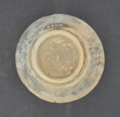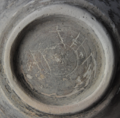MI·2: Difference between revisions
No edit summary |
No edit summary |
||
| (One intermediate revision by the same user not shown) | |||
| Line 1: | Line 1: | ||
{{inscription | {{inscription | ||
|reading=atep | |reading=atep | ||
|reading_lepontic={{c|A|A21}}{{c|T| | |reading_lepontic={{c|A|A21}}{{c|T|T7|d}}{{c|E|E7|d}}{{c|P||d}} | ||
|direction=dextroverse | |direction=dextroverse | ||
|letter_height_min=0.6 cm | |letter_height_min=0.6 cm | ||
| Line 31: | Line 31: | ||
Images in {{bib|Tizzoni 1984}}: tav. XLIV e (drawing = {{bib|Solinas 1995}}: 367, no. 109), {{bib|Frontini 1985}}: tav. 16.12 (drawing). | Images in {{bib|Tizzoni 1984}}: tav. XLIV e (drawing = {{bib|Solinas 1995}}: 367, no. 109), {{bib|Frontini 1985}}: tav. 16.12 (drawing). | ||
Inscribed in a curve on the foot of the cup, with the upper parts of the letters pointing outward. Initial alpha is retrograde and has a shortened first hasta | Inscribed in a curve on the foot of the cup, with the upper parts of the letters pointing outward. Initial alpha is retrograde and has a shortened first hasta. Frontini's drawing shows non-retrograde alpha {{c||A|d}} as the final letter; {{bib|Tibiletti Bruno 1984}}: 123 also reads alpha (discounting the bar of tau and reading upsilon {{c||U|d}} as second letter, followed by a single iota → ''auia'' in Latin script). However, the impression of a lower bar in the last letter is due to one of the concentric circles on the foot (and a combination of two entirely different forms of alpha would be unlikely anyway). Tizzoni's drawing correctly shows {{c||P|d}} pi or, less likely, inverted lambda as the final letter; Morandi accordingly reads {{c||A21}}{{c||T7|d}}{{c|I||d}}{{c|I||d}}{{c|L|L2|d}} ''atiil'' or ''atiip'', assuming an abbreviated personal name and comparing specifically {{w||atilonei}}. Double iota, however, is not otherwise attested in language-encoding Cisalpine Celtic inscriptions; since Latin or Latinised script is indicated by tau with a straight hasta and made plausible by the low dating, the two verticals are better read as cursive Latin epsilon {{c||E7|d}}. The letter forms of the inscription are very similar to those in the Latin alphabetarium at [[Carona]] ({{bib|Casini & Fossati 2013b}}), which also include retrograde alpha with a shortened first hasta, cursive epsilon, tau with inclined bar (on top of the hasta) and Lepontic pi (cf. {{bib|Salomon 2023}}: 23 f.). | ||
{{w||atep}} is an abbreviation of a personal name like {{w||ateporix}} vel sim. (see the word page). | |||
<p style="text-align:right;>[[User:Corinna Salomon|Corinna Salomon]]</p> | <p style="text-align:right;>[[User:Corinna Salomon|Corinna Salomon]]</p> | ||
{{bibliography}} | {{bibliography}} | ||
Latest revision as of 17:24, 23 January 2024
| Inscription | |
|---|---|
| Reading in transliteration: | atep |
| Reading in original script: | |
|
| |
| Object: | MI·2 Parabiago (cup) |
| Position: | foot, outside |
| Direction of writing: | dextroverse |
| Script: | prob. North Italic script (Lepontic alphabet) |
| adapted to: | Latin script |
| Letter height: | 0.6–1 cm0.236 in <br />0.394 in <br /> |
| Number of letters: | 4–5 |
| Number of words: | 1 |
| Number of lines: | 1 |
| Workmanship: | scratched after firing |
| Condition: | complete |
|
| |
| Archaeological culture: | Augustan [from object] |
| Date of inscription: | late 1st c. BC [from object] |
|
| |
| Type: | unknown |
| Language: | unknown |
| Meaning: | unknown |
|
| |
| Alternative sigla: | Solinas 1995: 109 Morandi 2004: 132 |
|
| |
| Sources: | Morandi 2004: 611 no. 132 |
Images
Commentary
First published in Tizzoni 1984: 72, no. 3. Examined for LexLep on 28th April 2022.
Images in Tizzoni 1984: tav. XLIV e (drawing = Solinas 1995: 367, no. 109), Frontini 1985: tav. 16.12 (drawing).
Inscribed in a curve on the foot of the cup, with the upper parts of the letters pointing outward. Initial alpha is retrograde and has a shortened first hasta. Frontini's drawing shows non-retrograde alpha ![]() as the final letter; Tibiletti Bruno 1984: 123 also reads alpha (discounting the bar of tau and reading upsilon
as the final letter; Tibiletti Bruno 1984: 123 also reads alpha (discounting the bar of tau and reading upsilon ![]() as second letter, followed by a single iota → auia in Latin script). However, the impression of a lower bar in the last letter is due to one of the concentric circles on the foot (and a combination of two entirely different forms of alpha would be unlikely anyway). Tizzoni's drawing correctly shows
as second letter, followed by a single iota → auia in Latin script). However, the impression of a lower bar in the last letter is due to one of the concentric circles on the foot (and a combination of two entirely different forms of alpha would be unlikely anyway). Tizzoni's drawing correctly shows ![]() pi or, less likely, inverted lambda as the final letter; Morandi accordingly reads
pi or, less likely, inverted lambda as the final letter; Morandi accordingly reads ![]()
![]()
![]()
![]()
![]() atiil or atiip, assuming an abbreviated personal name and comparing specifically atilonei. Double iota, however, is not otherwise attested in language-encoding Cisalpine Celtic inscriptions; since Latin or Latinised script is indicated by tau with a straight hasta and made plausible by the low dating, the two verticals are better read as cursive Latin epsilon
atiil or atiip, assuming an abbreviated personal name and comparing specifically atilonei. Double iota, however, is not otherwise attested in language-encoding Cisalpine Celtic inscriptions; since Latin or Latinised script is indicated by tau with a straight hasta and made plausible by the low dating, the two verticals are better read as cursive Latin epsilon ![]() . The letter forms of the inscription are very similar to those in the Latin alphabetarium at Carona (Casini & Fossati 2013b), which also include retrograde alpha with a shortened first hasta, cursive epsilon, tau with inclined bar (on top of the hasta) and Lepontic pi (cf. Salomon 2023: 23 f.).
. The letter forms of the inscription are very similar to those in the Latin alphabetarium at Carona (Casini & Fossati 2013b), which also include retrograde alpha with a shortened first hasta, cursive epsilon, tau with inclined bar (on top of the hasta) and Lepontic pi (cf. Salomon 2023: 23 f.).
atep is an abbreviation of a personal name like ateporix vel sim. (see the word page).
Bibliography
| Casini & Fossati 2013b | Stefania Casini, Angelo E. Fossati, "L'alfabeto latino inciso sul masso Camisana 1 di Carona (Bergamo)", Notizie Archeologiche Bergomensi 21 (2013), 147–155. |
|---|


